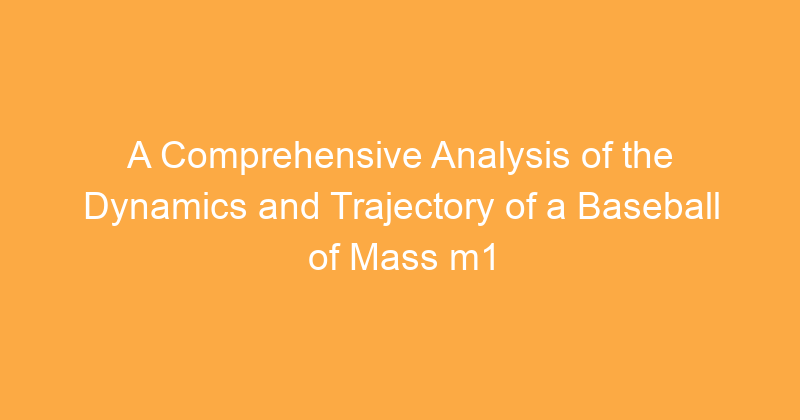Understanding the motion and trajectory of a baseball is crucial in the realm of baseball physics. The mass of the baseball, denoted as m1, plays a significant role in determining its behavior as it is propelled through the air. This article aims to provide an in-depth exploration of the dynamics and trajectory of a baseball of mass m1.
The mass of a baseball, typically around 0.145 kilograms, is a crucial factor in determining its acceleration due to gravity. As the baseball is released from the pitcher’s hand, its mass m1 experiences a downward force due to gravity, known as weight (mg). This force, acting in the downward direction, accelerates the baseball towards the ground. In the absence of air resistance, the baseball would continue to accelerate downward at a constant rate of g, approximately 9.8 meters per second squared.
However, the presence of air resistance introduces a drag force that opposes the motion of the baseball. This drag force, dependent on the velocity and shape of the baseball, acts in the opposite direction to the baseball’s velocity. As the baseball travels through the air, the drag force gradually reduces its acceleration due to gravity. Eventually, the drag force becomes equal to the weight of the baseball, resulting in a constant velocity known as the terminal velocity.
Initial Conditions
-
Mass (m1)
The mass of the baseball is a crucial factor in determining its behavior. A heavier baseball will experience a greater force due to gravity, resulting in a more rapid acceleration and a higher terminal velocity.
-
Initial Velocity (v0)
The initial velocity of the baseball, imparted by the pitcher’s throw, significantly affects its trajectory. A higher initial velocity will result in a longer range and a different flight path.
-
Angle of Projection (θ)
The angle at which the baseball is released from the pitcher’s hand influences its trajectory. A steeper angle of projection will result in a higher maximum height and a shorter range.
Equations of Motion
-
Horizontal Motion
The horizontal motion of the baseball is governed by the equation:
x = v0 * cos(θ) * t -
Vertical Motion
The vertical motion of the baseball is governed by the equation:
y = v0 * sin(θ) * t – (1/2) * g * t^2
Drag Force
-
Drag Coefficient (Cd)
The drag coefficient is a dimensionless quantity that characterizes the shape and roughness of the baseball. A higher drag coefficient indicates a greater resistance to air flow.
-
Projected Area (A)
The projected area is the cross-sectional area of the baseball facing the oncoming air. A larger projected area will experience a greater drag force.
Terminal Velocity
-
Balance of Forces
At terminal velocity, the drag force is equal to the weight of the baseball, resulting in no acceleration. The baseball continues to move at a constant velocity.
-
Equation for Terminal Velocity
The terminal velocity (vT) is given by the equation:
vT = sqrt((2 * m1 * g) / (Cd * A * ρ))
Range
-
Horizontal Range
The horizontal range of the baseball, the distance it travels before landing, is determined by:
R = (v0^2 * sin(2θ)) / gAlso Read: During Deposition, What Not to Do
-
Effect of m1 on Range
The mass of the baseball (m1) affects the range. A heavier baseball will typically have a shorter range due to its increased drag force and lower terminal velocity.
Height
-
Maximum Height
The maximum height reached by the baseball is achieved at the point where its vertical velocity becomes zero. It is calculated using the equation:
h = (v0^2 * sin^2(θ)) / (2 * g) -
Effect of m1 on Height
The mass of the baseball (m1) has a minimal effect on the maximum height reached. The primary factor influencing height is the initial velocity and the angle of projection.
Spin
-
Magnus Effect
The spin of the baseball can induce a Magnus effect, which is a force perpendicular to both the baseball’s direction of travel and its axis of spin.
-
Curveball
The Magnus effect is harnessed by pitchers to throw curveballs, which deviate from a straight trajectory due to the spin-induced force.
Conclusion
The dynamics and trajectory of a baseball of mass m1 are influenced by various factors, including its initial conditions, mass, drag force, terminal velocity, range, height, and spin. Understanding these factors is essential in comprehending the physics of baseball and the intricate interplay of forces that govern the flight path of a baseball.















Leave a Comment